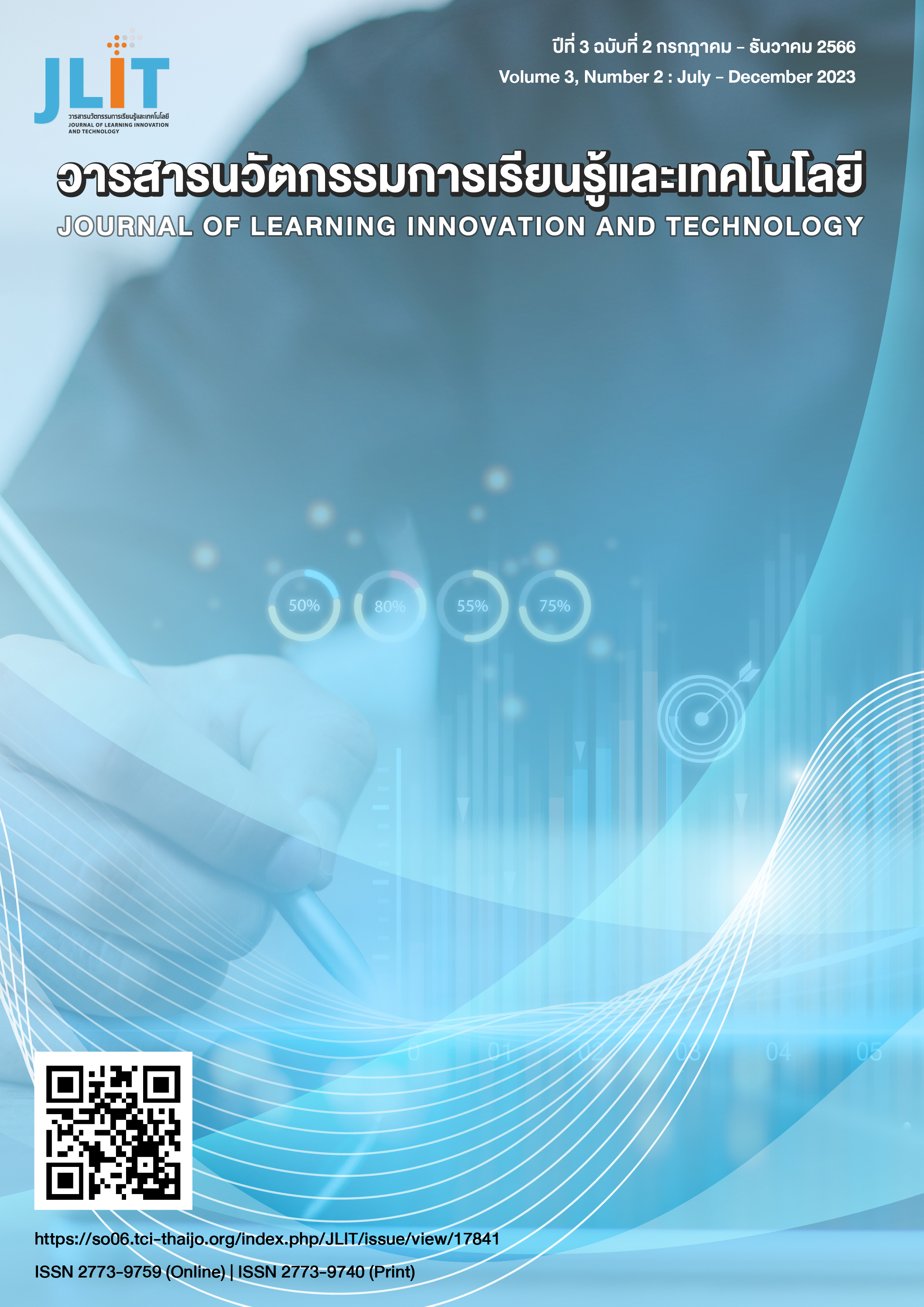การสำรวจทัศนคติของผู้เรียนภาษาอังกฤษเป็นภาษาต่างประเทศที่มีต่อเทคโนโลยี จักรวาลนฤมิตรในการเรียนภาษา
คำสำคัญ:
Virtual Reality Technology, Language Learning, English as Foreign Language Learners’ Attitudes, Immersive Learningบทคัดย่อ
This research aims to explore the attitudes of English as Foreign Language learners towards virtual reality technology in language learning and to highlight the most recent developments and future possibilities in the field of VR technology usage in language learning. In this study, one-group pre- and post-test design was used to collect and analyze the data on students' attitudes before and after. Additionally, an explanation of VR learning experiences in English classes (GE course) was provided in detail. The questionnaires were analyzed to determine the students' perspectives on the use of VR technology in English language education. After gaining an understanding and trial of VR technology in language learning, the students' attitudes toward VR interactivity in language learning was significantly different, as shown by the results. With a mean score of 4.57, the results showed that English as Foreign Language learners had a positive view of VR technology as a way to learn a language in immersive learning. Most of the interviewees' points of view fell into three main categories: 1) interaction, 2) concentration, and 3) memorization. Future study directions are recommended in order to determine the implications of virtual reality on language acquisition.
เอกสารอ้างอิง
Mantelli, A., 2021, Learning Japanese through VR Technology. The Case of Altspace VR. Annali di Ca’ Foscari. Serie orientale, Vol. 57, pp. 663-684.
Ageenk, N., Dobrova, V., Gorbunova, Y., Labzina, P., Trubitsin, K., 2017, Virtual Reality in Teaching of Foreign Languages, Advances in Social Science, Education and Humanities Research (ASSEHR), vol. 97.
Pomerantz, J., 2019, XR for Teaching and Learning: Year 2 of the EDUCAUSE/HP Campus of the Future Project, ECAR research report, EDUCAUSE, Louisville.
Brown, M., McCormack, M., Reeves, J., Brook, D.C., Grajek, S., Alexander, B. and Weber, N., 2020, 2020 Educause Horizon Report Teaching and Learning Edition, EDUCAUSE, pp. 2-58.
Lin, T.J. and Lan, Y.J., 2015, Language learning in virtual reality environments: Past, present, and future, Journal of Educational Technology and Society, Vol. 18(4), pp. 486-497.
Chen, Y., Smith, T.J., York, C.S. and Mayall, H.J., 2019, Google Earth Virtual Reality and expository writing for young English learners from a Funds of Knowledge perspective, Computer Assisted Language Learning, Vol. 33:1- 2, pp. 1-25.
Radianti, J., Majchrzak, T.A., Fromm, J. and Wohlgenannt, I., 2020, A systematic review of immersive virtual reality applications for higher education: Design elements, lessons learned, and research agenda, Computers and Education, Vol. 147, April 2020, Article 103778.
Li, P., Legault, J., Klippel, A. and Zhao, J., 2020, Virtual reality for student learning: Understanding individual differences. Human Behaviour and Brain, Vol. 1(1), pp. 28-36.
Wang, S. and Iwata, J., 2018, Language Learning Using AR and VR Technology: A Review, URL: https://ir.lib.shimane-u.ac.jp/files/public/4/40890/20180417131313566637/外国語教育センタージャーナル_13_27_33.pdf.
Milton, J., 2007, Measuring Second Language Vocabulary Acquisition, ISBN: 9781847692078, Multilingual Matters, Bristol.
Dobrova, Victoria & Trubitsin, K. & Labzina, P. & Ageenko, N. & Gorbunova, Yu., 2017, Virtual Reality in Teaching of Foreign Languages, Conference: 7th International Scientific and Practical Conference "Current issues of linguistics and didactics: The interdisciplinary approach in humanities", Dordrecht, The Netherlands.
Standen, P. and Brown, D., 2014, Mobile learning and games in special education, The SAGE handbook of special education, SAGE, London, pp. 719-730.
Rheingold, H., 2011, Foreword, Physical and Virtual Learning Spaces in Higher Education: Concepts for the Modern Learning Environment, IGI Publishing (IGI Global), Hershey, PA. United States.
Chawla, M., 2019, Immersive Learning - Bringing Learning to Life through Immersive Experiences, Cognizant 20-20, Insights, pp. 1-10.
AdvancED., 2015, Learning in 3D: Making STEM Real, URL: https://www.advanced.org/source/learning3d-making-stem-real, accessed on 01/05/2022
3DLabs., 2019, Virtual Reality and Augmented Reality, URL: http://www.3d- labs.co.uk/virtual-reality/, 2019, accessed on 01/05/2022.
Adnan, A. H. M., Ahmad, M. K., Yusof, A. A., Mohd Kamal, M.A., and Mustafa Kamal, N. N., 2019, English Language Simulations Augmented with 360-degree spherical videos (ELSA 360°-Videos): ‘Virtual Reality’ real life learning!, Leading Towards Creativity and Innovation (Series 1), pp. 82-88.
Doucet, A., Evers, J., Guerra, E., Lopez, N., Soskil, M., Timmers, K., 2018, Teaching in the Fourth Industrial Revolution: Standing at the Precipice. Oxford, Routledge.
Adnan, A. H. M., Ahmad, M. K., Yusof, A. A., Mohd Kamal, M.A., and Mustafa Kamal, N. N., 2019, Using new technologies to teach English in Malaysia – issues and challenges, Proceedings of the Int’l Invention, Innovative and Creative Conference, Series 1/2019, pp. 203-207, Perpustakaan Negara, Malaysia.
Mohd, K. N., Adnan, A. H. M., Yusof, A. A., Ahmad, M. K., and Mohd Kamal, M. A., 2019, Teaching Arabic Language to Malaysian University Students using Education Technologies based on Education 4.0 Principles, Proceedings of the Int’l Invention, Innovative & Creative Conference, Series 2/2019, pp. 38-51, Perpustakaan Negara, Malaysia.
Rüfenacht, M., 2017, Education5.0 whyweneedtoadjusttheeducationsystem, URL: https://medium.com/@MattiaSuisse/education-5-0-why-i-think-we-need-to- adjust-the-education-system-4a669 b26396d, accessed on 27/05/2022.
Bell, E., and Bryman, A., 2011, Business Research Methods. 3rd edition, ISBN: 0199583404, Oxford University Press, New York.
Hu-Au, E. and Lee, J. J., 2017, “Virtual reality in education: a tool for learning in the experience age,” Int. J. Innov. Educ., vol. 4, no. 4, p. 21.
Bogusevschi, D., Muntean, C. and Muntean, G.-M., 2020, Teaching and Learning Physics using 3D Virtual Learning Environment: A Case..., J. Comput. Math. Sci. Teach., vol. 39, no. 1, pp. 5– 18.
ดาวน์โหลด
เผยแพร่แล้ว
ฉบับ
ประเภทบทความ
สัญญาอนุญาต
ลิขสิทธิ์ (c) 2023 วารสารนวัตกรรมการเรียนรู้และเทคโนโลยี

อนุญาตภายใต้เงื่อนไข Creative Commons Attribution-NonCommercial-NoDerivatives 4.0 International License.
จริยธรรมในการตีพิมพ์บทความ
- กองบรรณาธิการขอสงวนสิทธิ์พิจารณาบทความที่มีรูปแบบและคุณสมบัติที่ครบถ้วนตามข้อกำหนดเท่านั้น หากบทความนั้นไม่ตรงตามข้อกำหนด กองบรรณาธิการฯ มีสิทธิ์ในการปฏิเสธลงตีพิมพ์
- ในการขอหนังสือตอบรับการตีพิมพ์ กองบรรณาธิการฯจะออกให้ในกรณีที่บทความนั้นพร้อมที่จะลงตีพิมพ์โดยไม่มีเงื่อนไขเท่านั้น
- การพิจารณาบทความ (Peer review) ของวารสารนวัตกรรมการเรียนรู้และเทคโนโลยีถือเป็นที่สิ้นสุด ผลงานวิชาการอาจไม่ได้ลงตีพิมพ์ในเล่มที่กำหนดไว้จนกว่าจะผ่านการพิจารณาบทความ (Peer Review) และพร้อมจะลงตีพิมพ์เผยแพร่แล้วเท่านั้น
- งานวิจัยที่เกี่ยวข้องกับจริยธรรมของการวิจัยในมนุษย์และสัตว์จะต้องผ่านการประเมินโดยกรรมการจริยธรรมของต้นสังกัด
- บทความที่ส่งมาต้องไม่เคยเผยแพร่ในสิ่งพิมพ์อื่นใดมาก่อน และต้องไม่อยู่ในระหว่างการพิจารณาของวารสารอื่น บทความที่ได้รับการตีพิมพ์ถือเป็นลิขสิทธิ์ของวารสาร JLIT



